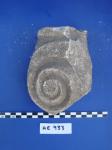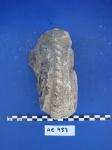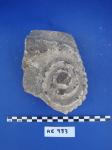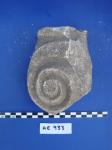
Illustrations
- No uploaded files
Description
- Medieval capital volute
- Unknown (due to worn state)
- 1
- 13.8
- 9.5
- 11.0
- The fragment is discoloured and pitted on all surfaces. Dark brown patches colour one side.
- AE 933 is a volute that once sprang from the corner of a capital. It is carved on three sides, including its profile, which is embellished with a simple guilloche pattern. The volute scrolls (d. 12.7 cm) are thick, with a square profile where they once sprang from the body of the capital. After the first half-revolution they narrow significantly and their profile peaks. The scrolls terminate with a flat round eye (d. 2.4 cm). The spiral on side A is smaller than that of side B and slightly ovoid.
- Similar volutes were unearthed at S. Vincenzo al Volturno and favorably compared by John Mitchell to the capitals that topped the columns of the canopy over the font of the patriarch Callixtus at the cathedral of Cividale (Michell, et al. (eds), 2001, 156–57). The Villamagna pieces are, however, more fragmentary than those at S. Vincenzo. A number of comparable examples are held at the Museo Cristiano, Brescia and at S. Salvatore (G. Panazza and A. Tagliaferri 1966, nos 109–14 and 169–71). In all these examples, two volutes come together to form the corner of a square capital. Panazza and Tagliaferri compare the S. Salvatore capitals to ninth-century examples from the abbey of Fontaneto and SS. Feliciano, Leggiuno (1966, 133). More modest examples, closer in scale to the S. Pietro fragments, are part of the collection of the Museo del Sannio, Benevento (Rotili 1966, nos 34–7). These have been dated to the last ten years of the seventh century (a time of considerable architectural activity in Benevento, due to the rise of the Lombard duchy and the establishment of Benevento as a second capital). It is unlikely that AE 1050 is as early. At SS. Giovanni e Paolo, Ferentino, volutes very like AE 1050 are part of a fragment of a demi-capital that once capped a pilaster (Ramieri 1983, no. 12).
Record Details
-
VM_4290
- Strato di terra scura con cenere e carboni posizionato nella zona N del saggio BII sotto 4265.














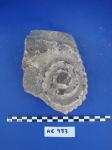
![Download [view]](/villamagna/ark//skins/villamagna/images/results/download_sml.png)
